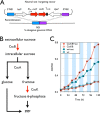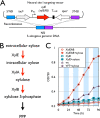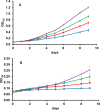Heterotrophy among Cyanobacteria
- PMID: 37744813
- PMCID: PMC10515406
- DOI: 10.1021/acsomega.3c02205
Heterotrophy among Cyanobacteria
Abstract
Cyanobacteria have been studied in recent decades to investigate the principle mechanisms of plant-type oxygenic photosynthesis, as they are the inventors of this process, and their cultivation and research is much easier compared to land plants. Nevertheless, many cyanobacterial strains possess the capacity for at least some forms of heterotrophic growth. This review demonstrates that cyanobacteria are much more than simple photoautotrophs, and their flexibility toward different environmental conditions has been underestimated in the past. It summarizes the strains capable of heterotrophy known by date structured by their phylogeny and lists the possible substrates for heterotrophy for each of them in a table in the Supporting Information. The conditions are discussed in detail that cause heterotrophic growth for each strain in order to allow for reproduction of the results. The review explains the importance of this knowledge for the use of new methods of cyanobacterial cultivation, which may be advantageous under certain conditions. It seeks to stimulate other researchers to identify new strains capable of heterotrophy that have not been known so far.
© 2023 The Authors. Published by American Chemical Society.
Conflict of interest statement
The authors declare no competing financial interest.
Figures






References
-
- Schmetterer G.Cyanobacterial respiration. In The molecular biology of cyanobacteria; Bryant D.A., Ed.; Kluwer Academic Publishers, 1994; pp 409–435.10.1007/978-94-011-0227-8_13. - DOI
-
- Schmetterer G.; Pils D.. Cyanobacterial respiration. In Respiration in archaea and bacteria; Zannoni D., Ed.; Diversity of prokaryotic respiratory systems, 2004; Vol. 16, pp 261–278.10.1007/978-1-4020-3163-2_12. - DOI
-
- Golbeck J. H.Photosystem I in cyanobacteria. In The molecular biology of cyanobacteria; Bryant D. A., Ed.; Kluwer Academic Publishers, 1994; pp 319–360.10.1007/978-94-011-0227-8_10. - DOI
-
- Barry B. A.; Boerner R. J.; de Paula J. C.. The use of cyanobacteria in the study of the structure and function of photosystem II. In The molecular biology of cyanobacteria; Bryant D. A., Ed.; Kluwer Academic Publishers, 1994; pp 217–257.10.1007/978-94-011-0227-8_8. - DOI
-
- Mereschkowski C. Über Natur und Ursprung der Chromatophoren im Pflanzenreiche. Biol. Centralbl. 1905, 25, 593–604.
Publication types
LinkOut - more resources
Full Text Sources
Molecular Biology Databases
Miscellaneous

